Today, sales automation is the most common trend among companies because they can immediately see its effectiveness.
Its importance comes from the fact that automation techniques and tools have been shown to increase productivity, reduce overhead, decrease wasted time, and boost the efficiency of sales and marketing team members.
To prove this, we’ve compiled a list of 51 stats that are based on surveys from thousands of business leaders and sales professionals about the actual impact of implementing a sales automation strategy.

Sales Impact
Increasing sales and decreasing the amount of friction to achieving them should be at the core of every sales automation strategy.
Knowing which sales automation tools to use for what is sometimes difficult to determine and then implement, so make sure you understand what sales team automation tools can be the most effective.
Here are some basic stats to begin:
- A third of all sales tasks can be automated. (McKinsey)
- 10% more companies using sales automation are likely to have high-growth than companies that are not using sales automation. (Hinge)
- In 2022, 49% of companies are using marketing automation tools. (Moosend)
Today, most companies are finding these three trends to be the case today: there are many tasks that can (and should) be automated, growing companies use automation for their growth strategy, and they’re adopting these tools at an increasing rate.
The statistics in the following sections will show you more specifically how and why these automation tools are being used.

Marketing Impact
The marketing department stands to benefit the most from the implementation of automation strategies. Most of the stats here will have to do with marketing automation techniques because they’re the most popular and effective.
Marketing plays a significant role at every step in the customer’s journey, so automation implementation means your customer and your company should benefit at every level.
- 58% of B2B companies and 33% of marketing teams plan to adopt automation software in 2022. (Emailmonday)
- In 2019, 75% of marketers were leveraging at least one kind of automation software. (Social Media Today)
- Marketing automation is the number one technique for marketers according to a worldwide survey. (Statista)
- More than a third of marketing and sales survey respondents said they used automation tools for streamlining tasks or improving the customer experience. (Ascend2)
- 91% of surveyed marketers said that marketing automation tools were very important for their strategies. (Instapage)
- In 2022, 69% of marketers say their customer journey is “partially” or “mostly” automated while 9% are fully automated. (Ascend2/Research Partners)
- In 2022, marketers using automation tools for content marketing management went up to 29% compared to 22% in 2021. (Ascend2/Research Partners)
- 84% of marketers say that their top priorities are successful because of automation strategies. (Ascend2)
As you can see, a substantial majority of marketers have either adopted marketing automation techniques or are satisfied with that adoption and find it essential.
Let’s look at the impact at each stage of the customer’s journey.

Awareness Phase
In this stage, the most important aspect is finding good leads fast, which is a repetitive task that automation tools are built for. There’s so much data out there on potential leads, so lead generation automation can be essential for many companies.
- Marketers with automation software find 16% more of their leads than companies without automation. (Hinge)
- 80% of users increased their leads from automation software. (Invesp)
- 60% of respondents said that marketing automation tools increased the quantity and quality of their leads. (Instapage)
- 55% of companies used marketing automation tools to increase the number of generated leads. (Spotler)
- Marketing automation can increase sales leads by 50% while also reducing the cost per lead by 33%. (Marketo)
- 75% of companies are effectively using automated landing pages for lead generation. (Advertising Reports)

Consideration Phase
Here is where the bulk of interactions between sales reps and qualified leads occurs. The end goal is to produce a customer that has been properly nurtured, meaning targeted with the appropriate content and information, at every level.
- Marketing automation software increases qualified leads by 451% for users who nurture prospects. (Annuitas)
- When using nurturing lead software, companies saw an increase of 225% in leads that led to sales opportunities. (Instapage)
- Sales automation tools increased the sales pipeline contribution of B2B companies by 10%. (Instapage)
Automated email marketing campaigns seem to be one of the best methods that marketing respondents used:
- Automated emails have an open rate 70.4% higher than non-automated email newsletters. (Instapage)
- Sales reps that use automated emails during the customer’s journey are 133% more likely to send relevant emails. (Instapage)
- 75% of email revenue comes from personalized automated email campaigns rather than generic emails. (DMA)
- Between 2021 and 2022, the rate of marketers using email marketing automation tools went up 15% to 55% overall. (Ascend2/Research Partners)
Automation tools also have a beneficial impact on customer service, either on your own site or social media pages:
- Chatbots save almost 30% on customer service costs. (Chatbots Life)
- Sales and marketing teams can save up to six hours per week automating their social media posts and ads. (Instapage)
- In 2020, 83% of marketing departments were using automation tools for social media posts while 75% were automating email marketing. (Advertising Reports)
- In 2022, 44% of marketers are using marketing automation tools for social media. (Ascend2/Research Partners)

Decision Phase
The point of nurturing leads is to guide them into deciding whether they should purchase your product or service.
- 77% of users saw an increase in conversion from automation software. (Invesp)
- 58% of marketing teams use automation for upselling. (Moosend)
- 63% of companies succeeding with their marketing automation strategies plan to increase their automation budgets. (Marketo/Ascend2)
- 74% of companies say that marketing automation has been either “very” or “quite” beneficial for their company. (B2Bmarketing.net/Circle Research)
- Over half of companies increased their conversion rates after adopting marketing automation tools.
- Lead nurturing through automation tools converted 15-20% of potential customers into sales. (Protocol)
- 70% of marketers found that measuring the success of marketing automation is “somewhat” or “very” easy. (Ascend2/Research Partners)
As you can see, most respondents benefited from converting leads into customers, as well as being able to measure that impact.
So how can this increase promote the bottom line?

Revenue Impact
Whether anything is automated or not, in the end it’s an increase in revenue that everyone is looking for. There are many strategies to improve revenue through automation, so make sure you become familiar with them.
- Marketing automation reduces marketing overhead by 12.2%. (Invesp)
- Marketing automation is helping 63% of companies outperform their competitors. (Lenskold)
- Marketing automation leads to a positive return on investment for 74% of companies, and 44% of those see a positive ROI in just six months. (Marketo)
- 72% of successful companies are using automation software while only 18% of unsuccessful companies are using automation. (Pedalix)
- 78% of marketers believe that their implementation of automation tools is the main reason for their increase in revenue. (Software Path)
- Automated email marketing campaigns generate on average 320% more revenue than non-automated emails. (Campaign Monitor)

Productivity Impact
The number one reason why most companies adopt sales automation tools is to save time and increase productivity.
- On average, marketing automation implementation increases sales productivity by 14.5%. (Invesp)
- 74% of respondents said that automation software’s ability to save them time was its biggest benefit. (Invesp)
- This study found that marketing automation tools increased productivity by 20%. (Nucleus)
- In 2020, 80% of business leaders said they planned to speed up their work process automation. (World Economic Forum)
- 78% of business leaders found that automation tools increase productivity across the entire company. (KRC Research)
- 85% of business leaders believe that automating tasks will give their sales reps more time to focus on goals beneficial to the company. (KRC Research)
- Optimizing productivity was the most important objective for 43% of respondents for their automation strategies. (Adestra)

Management Impact
Although most of the impact from sales automation comes from the marketing and sales team tasks, team management can also greatly benefit from automation. For instance, lead scoring automation tools allow team leaders to assign the right lead to the right sales rep more efficiently.
- 50% of business leaders said they planned to automate repetitive tasks. (World Economic Forum)
- By 2024, 69% of routine managerial work can be fully automated at the current rate of progress. (Gartner)
- On average, marketing automation reduces administrative overhead by 3.4%. (Marketo)
These are just a handful of the many statistics on how sales automation can effectively improve your business. It’s clear that most companies are adopting automation tools, utilizing them efficiently, and plan to use them more in the future.Want to see more content related to sales automation and it’s effectiveness? Send us a message at marketing@dyl.com
